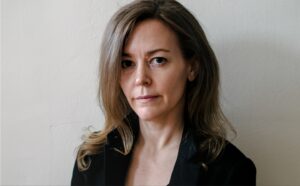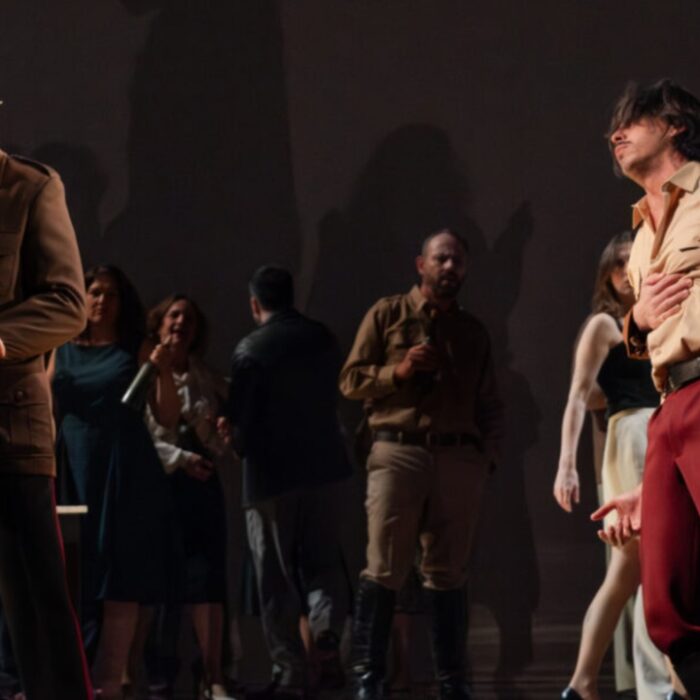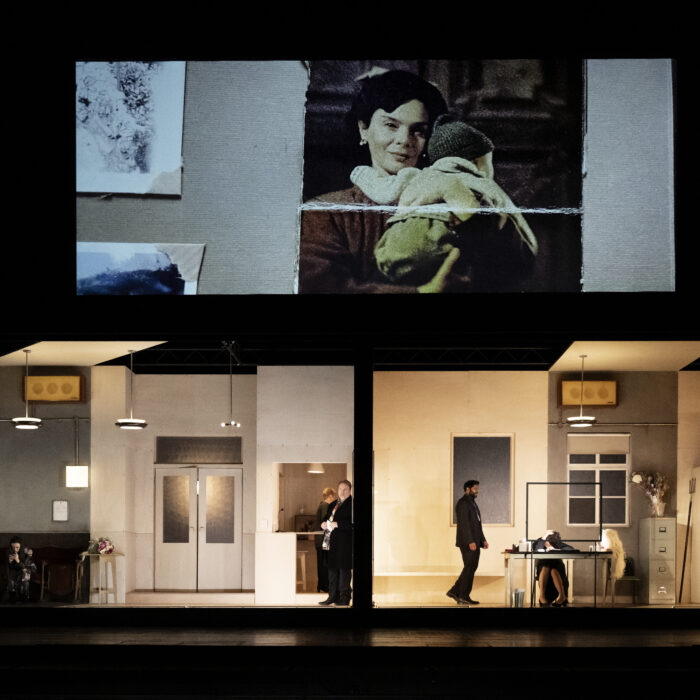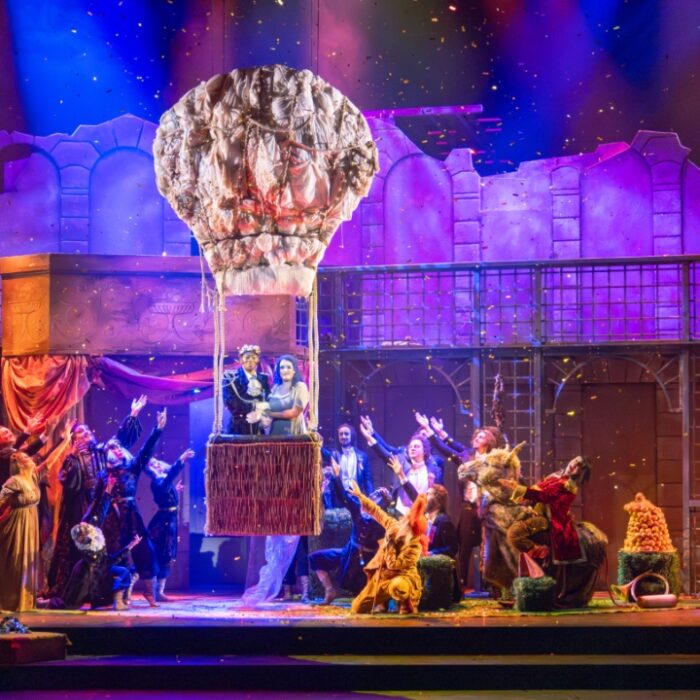
The Whitney Biennial 2022 Review: Raven Chacon’s ‘For Zitkála-Šá’
By Jennifer PyronRaven Chacon, a Pulitzer Prize-winning composer, performer, and installation artist from Fort Defiance, Navajo Nation, composed a series of 13 scores as portraits dedicated to different contemporary American Indian, First Nations, or Mestiza women working in music performance, composition, or sound art.
Currently on view in the 2022 Whitney Biennial, this work creates space for better understanding the Yankton Dakota composer and musician Zitkála-Šá (1876 to 1938) who devoted her life to bringing awareness to the oppression of Native people through her teachings, speeches and writings. The 13 scores include symbology and numerology of tribal geometries as a guide to awaken and express the inner-voice of each performance artist including Laura Ortman, Cherly L’Hirondelle, Suzanne Kite, Barbara Croall, Jacqueline Wilson, Autumn Chacon, Heidi Senungetuk, Ange Loft, Joy Harjo, Carmina Escobar, Olivia Shortt, Candice Hopkins and Buffy Sainte-Marie.
Zitkála-Šá is the first known Native person to write an opera, ‘The Sun Dance Opera” (1913), inspired by a sacred ceremony of spiritual healing that was outlawed by the U.S. Government. However, the increasingly oppressive environment did not squelch the power of Zitkála-Šá’s brilliant work as a violinist, composer, writer, editor, teacher and activist. Her legacy continues to create opportunities of activism as healing and awareness for those who choose to listen and engage.
Raven Chacon’s “For Zitkála-Šá” is a depiction of this level of awareness. Throughout his composition, Chacon sheds light in the dark and creates infinite openings that examine where one has been, where one is headed and how to navigate the inevitable conflict in-between. “For Zitkála-Šá” was performed live on Saturday, July 16th, 2022 in the Susan and John Hess Family Theater of the Whitney Museum. The theater setting was intimate, with every ticket sold. Audience members sat in silence and darkness before the projection screen showed the performance artist name as the title of the piece, along with the full score. This review follows along with the compositional score in order of performance artist interpretations.
“For Laura Ortman”
Laura Ortman (White Mountain Apache) is a solo performer and collaborative artist. She creates across multiple platforms, including recorded albums, live performances, and filmic and artistic soundtracks. Her performance of “For Laura Ortman” was based on a score composed of an open Western music notation with ambiguous hash marks on each quarter note. The layout of this design is specific to the stylizations of Ortman’s bowing, plucking and picking techniques through spacious means of interpretation which allow her overarching sound to be sculpted.
She also incorporated a fir tree branch which was attached to her bow and could be played. She utilized a pedal board to extend her technique with noise that felt playfully curious and intrinsically grounded. Her background in violin studies and live performance art gave her unique methods a grit and bite through a spirit of free-form and pure delight which was felt throughout the audience.
“For Cheryl L’Hirondelle”
Cheryl L’Hirondelle (Cree/Halfbreed; German/Polish) is an interdisciplinary, community-engaged artist, singer/songwriter and critical thinker whose family roots are from Papaschase First Nation, amiskwaciy wâskahikan (Edmonton, Alberta) and Kikino Metis Settlement, Alberta.
Her work critically investigates and articulates a dynamism of nêhiyawin (Cree worldview) in contemporary time-place. As a songwriter, L’Hirondelle’s focus is on both sharing nêhiyawêwin (Cree language) and Indigenous and contemporary song-forms and personal narrative songwriting as methodologies toward survivance. Her work as an activist in the broader community is a vital part of her work as a performer. Most specifically, her ongoing project with incarcerated women and men in federal prisons and correctional youth centers, entitled “Why the Caged Bird Sings,” encourages restorative community bonding. Her vocal career consists of bel canto-style voice instruction and classical composition training followed with contemporary songwriting workshops.
‘For Cheryl L’Hirondelle’ is notated as a presentation of five groupings of pitches which Raven Chacon outlines through the following text:
“For each grouping, compose and sing a melodic line that gives advice.
Interpret each grouping as a contour, as macro or micro as desired.
All five lines can become one song or become five separate songs.
To be performed in the dark.”
L’Hirondelle’s voice tells a story of remembering and forgetting through a series of chants while pacing back and forth, in the dark, on stage. For some, this performance may have felt like a series of birdsongs in a story-telling format. Her voice’s earthy spirit delivers a message as a warning about what happens when one loses the right to ancestral guidance. She expands the boundaries of art as activism in a way that invites the audience to explore a deeper calling of awareness along with her.
During this performance, the following internal questions may arise:
How does one listen to and embody a group of pitches? What is the message of the spirit that delivers these notes? Is there a way to better know the unseen through this moment and connect with all that is life?
“For Suzanne Kite”
Kite aka Suzanne Kite is an Oglala Lakota performance artist, visual artist, and composer. Her practice is grounded in Lakota philosophy which gives voice to better understanding the body in relationship to knowledge-making. Her works are grounded in live performance and listening awareness. She also co-runs the experimental electronic imprint, “Unheard Records.”
‘For Suzanne Kite’ activates numerology in design with the body. The score is a series of +/- numbers and X’s that invite the performance artist to freely decide in the moment how to value the symbol as a language. Kite interpreted this composition by deciphering as a process of prayer and honoring the work as a documentation to remember. She fully engaged her body, mind, spirit and strong backbone of Lakota philosophy to engage audience members with something more profound.
She also incorporated moments of noise in between spoken-words that fused together this decoding process in a modern way. Audience members were awe-struck with her raw portrait of art as decolonization and her higher understanding of the ways as knowing.
“For Barbara Croall”
Barbara Croall (Manitoulin Island, Kineu Dodem) is an Odawa composer and traditional Native flute performer. Her practice incorporates listening to different bird calls, remembering the first songs she ever heard sang to her by her mom as comforting lullabies, and examining through live performance the organic timbre of different woods used to construct her Anishinaabte flutes. Croall was taught by her elders to listen to the birds and never forget them as the “first singers.” “For Barbara Croall” oscillates between traditional technique, with overblowing and warbling that is reminiscent of a bird call. Raven Chacon notes in the composition:
“For flute
For breathing, and holding a tone as long as possible
While singing
While humming
While whistling
While hissing”
“For Jacqueline Wilson”
Dr. Jacqueline Wilson is a Yakama bassoonist, pedagogue, collaborator and advocate. She embraces new works for bassoon as a way to inspire diversification and repurpose traditional repertoire techniques. Her process for Raven Chacon’s composition centers around pure tone as an authentic realization of self.
She speaks about how Zitkála-Šá influences her practice when she says, “To stand on the shoulders of such awe-inspiring resilience is humbling, and yet the realities of this harm underscore the conflicted relationship between Native world-views and the many Eurocentric societal systems I must traverse daily.”
Dr. Jacqueline Wilson’s live performance was powerfully uncomplicated in its emblematic message and yet complex in its timbral manipulations. Audience members were on a sonic journey with Wilson that felt genuine and in many ways provided respite at the end when she sounded nine notes of endurance.
“For Autumn Chacon”
Autumn Chacon is a Diné and Xicana artist and activist. She builds electronic installations as a form of story-telling and often collaborates with her sister Nani Chacon through design based electronic installations called HÓLÓ. She views sound and/or radio frequencies as a gift, a means to infinitely connect with all that is.
“For Autumn Chacon” is a live performance documentation of radio frequencies and the human voice. She designed her installation based on a dual schematic of a basic radio studio for your DIY pirate radio station, which she discusses more in detail in Raven Chacon’s composition book.
Autumn Chacon’s performance was pure experimental sound art featuring radios and lanterns located at the corners of the stage. Her concept was clearly formatted and designed by means of self-driven attention to detail surrounding the electromagnetic frequency spectrum (EMFS) in connection with her body. She effectively demonstrated the process of discussion around what it means to occupy an “open channel” and how this occupation creates a frequency that is either supported or unsupported. Legal or illegal.
She says in her performance description, “When we vibrate on a frequency, remember that we are not the only ones who have an antenna to receive it. Bugs, deer, trees, and many things can intercept our vibration, so send them a shout-out.”
“For Heidi Senungetuk”
Dr. Heidi Senungetuk is a violinist and ethnomusicologist who researches Indigenous music of Arctic regions. Her work explores traditional forms of Inupiaq music and dance and interpretations of Indigenous contemporary music and art. ‘For Heidi Senungetuk’ is composed of five hand-drawn Noligraph five-line musical staff drawings.
Raven Chacon includes the following text notes: “Place a sheet of tracing paper over the score page (also printed on tracing paper), so the staves are visible through the overlaid sheet. Compose a melody by drawing noteheads in position on this overlaid sheet of paper over the first staff on the score. Place the tracing paper with the drawn noteheads behind the score page. Trace the row of noteheads onto each staff of the score page, aware that the noteheads may represent new pitches. Perform the five staves seamlessly with any instrument, at a pace so that the total duration of the performance is five minutes.”
Dr. Senungetuk’s live performance was the opener of the Whitney series. Her precision and connection to the composition were seamless as she played her melody with her violin. In Chacon’s composition book, Dr. Senungetuk speaks in detail about her experimenting with reclaiming tavlugun – ancestral Iñupiaq women’s chin tattoos. This performance gave space to Raven Chacon’s work and illuminated Dr. Senungetuk’s inner-voice through her violin’s sound. There were moments were the melody would turn-around and create new pitches. Giving room for newness to breathe, cultivate and flourish.
“For Ange Loft”
Ange Loft is an interdisciplinary performing artist and initiator from Kahnawà:ke Kanien’kehá:ka Territory, working in Tsi Tkarón:to. She is an ardent collaborator, consultant, and facilitator working in arts based research, wearable sculpture, theatrical co-creation and Haudenosaunee history.
“For Ange Loft” is a composition for voice and two drums. This work is a sound event and performed by alternating beating both drums while singing words or vocables. Ange’s performance was exquisite and masterful. Like clockwork she engaged both her drums and hands in exactness that made this performance a work of art. Audience members were fully engaged in her every movement and did not take their eyes and ears off her.
She describes in her text for this score, “It’s funny how some people like making music and I feel like I need to find the secret moments when I’m allowed to. Or not even… Where I can actually hide and do it without many people noticing.”
“For Joy Harjo”
Joy Harjo is an internationally renowned performer and writer of the Muscogee (Creek) Nation. She served three terms as the 23rd Poet Laureate of the United States from 2019-2022. She is the author of nine books of poetry and is Executive Editor of the anthology When the Light of the World was Subdued, Our Songs Came Through — A Norton Anthology of Native Nations Poetry and the editor of Living Nations, Living Words: An Anthology of First Peoples Poetry, the companion anthology to her signature Poet Laureate project.
“For Joy Harjo” was a video recording of her live performance at Tulsa’s Woody Guthrie Center. The composition was performed with voice and played with saxophone. She interpreted the score with enthusiasm and fluidity that lifted the notes into the ether. She describes Raven Chacon’s work very visually by saying, “[His] scoring presents a different system of approaching composition and performance. The performer is brought into the music in a unique manner. The paper feels like land, even sandstone. There is orientation according to direction. What appears to be the title is also the key to the map. It is in the graphic symbols.”
“For Carmina Escobar”
Carmina Escobar is an experimental vocalist, improviser, and sound and intermedia artist from Mexico City. Her practice—comprising installation, performance, and multimedia projects—focuses on sound, the voice, and the body, and their interrelations with physical, social, present, and memory spaces. ‘For Carmina Escobar’ is notated in text along with circles and triangles by Raven Chacon:
“For the quietest screams in the world.
The shape of the mouth is indicated.
The micro-volume and duration of each scream is also indicated.
The triangles are reverse-screams.”
Carmina Escobar’s voice amassed every possible emotion in her live performance. Between screams, gasps, wails and glottal noise, Escobar stood like a terrifying statue on stage. Examining the audience, her eyes pierced from underneath a carmine colored veil. Affirming the scariest existence of fear imaginable in her eyes, body and especially voice. She wore long black gloves with bright red nails while holding a heart in her hands that was suspended by a chain around her neck. Symbolizing the raw terror that lays beneath the surface, sometimes in the moment and out in the open. Carmina Escobar’s performance was legendary.
“For Olivia Shortt”
Olivia Shortt (They/Them: Anishinaabe, Nipissing First Nation) Olivia Shortt is a Tkarón:to-based storyteller and performing artist. They are a multi-instrumentalist, vocalist, noisemaker, improviser, composer, sound designer, video artist, drag artist, curator, administrator, and producer.
“For Olivia Shortt” is for a performer with any instrument surrounded by an audience of at least eleven people. Olivia Shortt’s live performance consisted of a saxophone and RC300 loop station. They played according to Raven Chacon’s notations and created an atmospheric response to their surroundings that felt actively present and alive. Olivia Shortt’s timbral effects resonated the walls of the theater. They dressed in Native colors with beautiful pants and a cape. The performance was an exquisite display of thoughtful interpretation.
“For Candice Hopkins”
Candice Hopkins is a citizen of Carcross/Tagish First Nation and lives in Red Hook, New York. Her writing and curatorial practice explore the intersections of history, contemporary art, and Indigeneity. She is Executive Director of Forge Project, Taghkanic, NY, and Senior Curator for the 2019 and 2022 editions of the Toronto Biennial of Art.
“For Candice Hopkins” was performed using an overhead projector and transparencies. In her process, Hopkins spoke about her reclamation and showed ways in which, as she says, “language is formed in relation to the land, to the water.”
Raven Chacon’s score intuitively outlines Hopkins’ work and creates a frame for her intelligent interpretation. The live performance was the only one that utilized an overhead projector and this made Hopkins’ reclamation feel uniquely her own.
“For Buffy Sainte-Marie”
Buffy Sainte-Marie CC (Order of Canada) is an Indigenous Canadian-American singer-songwriter, musician, Oscar-winning composer, visual artist, educator, pacifist, and social activist. “For Buffy Sainte-Marie” is a composition of lines and intervals designed to shift the meaning and parameters of the lines’ interpretation.
This score is very open to how it can be performed and read by the performer. Buffy Sainte-Marie’s live performance was insightful and called to mind the many ways in which art can be expressed, understood and shared. Her voice continuously reminds us all how important it is to remain vigilant as an activist and to never back down from the truth that remains at the core of all that is.



